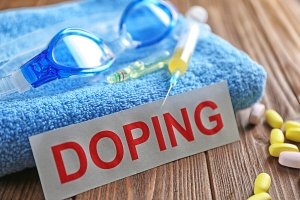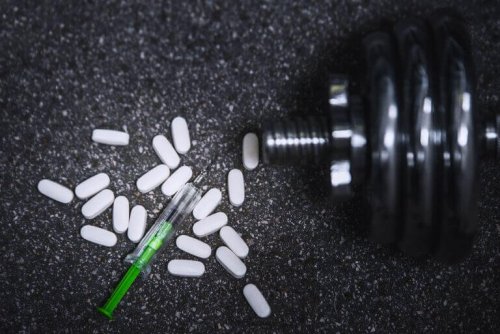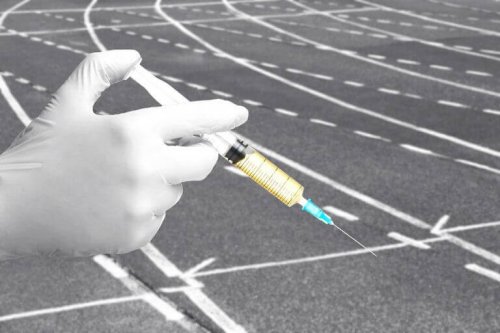What are the 15 Prohibited Substances in Sports?

Every day the list of prohibited substances in sports increases. Athletes should respect this list in order to avoid serious sanctions.
Positive doping results mean the removal of titles, medals, and the suspension or even expulsion from the sport. Continue reading to find out what the main illegal substances are in athletics.
Prohibited substances in sports
The worldwide anti-doping agency or WADA has the objective of monitoring the fight against sports doping. It’s for this reason, that they’ve compiled a list of illegal substances in sports.
There are three large groups of substances: those not currently legal, those illegal in competition and those that are not permitted in certain sports.
1. Unapproved substances
These are substances that are in the experimental or development phase. There are no results or complete tests for the effects they have on people.
2. Anabolic agents
Steroids are the best known of these agents. They’re a derivative of the sex hormone testosterone. Stanozolol is also in the anabolic agent group as well as nandrolone and clenbuterol.
3. Peptide hormones: prohibited substances
Among the prohibited substances in sports, erythropoietin or EPO is one of the most common. To explain, this is an endogen hormone that stimulates the production of red blood cells. For example, Lance Armstrong, the cyclist lost all of the titles he achieved in his career for using EPO. This is one of the most famous cases.
4. Beta-2 agonists
Due to the fact that it affects bronchodilators, it helps people with asthma. Therefore, because it facilitates respiration and can reduce physical effort, it’s prohibited. The beta-2 agonists include vilanterol, albuterol, fenoterol, and reproterol.

5. Hormones and metabolism moderators: prohibited substances
These moderators reduce certain effects of hormones in the body, particularly those that relate to growth and muscular development. For example, insulin, antiestrogen substances and estrogen receptors are in this group.
6. Diuretics and masked prohibited substances
These are substances that aren’t allowed in any instance including entertainment, competitions, or postseason times. Consequently, their objective is to cover up the use of illegal substances. They affect the kidneys by increasing the secretion of urine.
7. Manipulation of blood
Still illegal, are blood or plasma transfusions. Other actions are dialysis and any other methods that modify components of blood.
8. Chemical or physical manipulation: prohibited substances
In this instance, we don’t mean methods that alter blood or urine samples. For example, we refer to another person that isn’t an athlete or was a previous athlete consuming illegal substances in sports.
9. Genetic doping
It’s not in common use, but the AMA also includes a list of prohibited methods. Nevertheless rare, genetic doping means altering the genetic information or using modified cells.
10. Stimulants: obviously prohibited substances
Because they increase the level of activity and short term physical and mental performance, these are substances that are banned during competitions. Among the most common are ephedrine, cocaine, amphetamines, and methylphenidate.
11. Narcotics
This includes all of the substances that can have analgesic or sedating effects on the body. For instance, these would include drugs such as morphine, heroin, methadone, oxycodone, and fentanyl.
12. Cannabinoids
These are all of those substances derived from cannabis, both natural and synthetic. Of course, the most common is marijuana. Nevertheless, the effects on athletes and their performance are questionable. However, they’re still illegal in sports.
13. Glucocorticosteroids
Lessening the use of glucose in the blood, and increasing strength is part of glucocorticosteroids. As a result, they improve performance in high-intensity competitions or those that are lengthy. For example, some of these are prednisone, hydrocortisone, and dexamethasone.

14. Alcohol, a prohibited substance in some sports
If athletes consume alcohol in large quantities its effects are disastrous for the body. In certain sports, such as motorsports, alcohol is illegal. Included in this group are auto racing, motorcycle sports, speedboat racing, archery, aeronautics, and martial arts such as karate.
15. Beta-blockers: prohibited substances
The most common substance in this group is propanol. In this case, the main effect is the reduction of palpitations and shaking. This is why athletes can’t use them in precision sports such as shooting, golf or archery. Nor can they use them in darts, pool, auto sports, skiing or snowboarding.
In the AMA there’s a very detailed explanation of illegal and prohibited substances. As mentioned above, their use can mean very strict sanctions for those who choose to consume them.
Every day the list of prohibited substances in sports increases. Athletes should respect this list in order to avoid serious sanctions.
Positive doping results mean the removal of titles, medals, and the suspension or even expulsion from the sport. Continue reading to find out what the main illegal substances are in athletics.
Prohibited substances in sports
The worldwide anti-doping agency or WADA has the objective of monitoring the fight against sports doping. It’s for this reason, that they’ve compiled a list of illegal substances in sports.
There are three large groups of substances: those not currently legal, those illegal in competition and those that are not permitted in certain sports.
1. Unapproved substances
These are substances that are in the experimental or development phase. There are no results or complete tests for the effects they have on people.
2. Anabolic agents
Steroids are the best known of these agents. They’re a derivative of the sex hormone testosterone. Stanozolol is also in the anabolic agent group as well as nandrolone and clenbuterol.
3. Peptide hormones: prohibited substances
Among the prohibited substances in sports, erythropoietin or EPO is one of the most common. To explain, this is an endogen hormone that stimulates the production of red blood cells. For example, Lance Armstrong, the cyclist lost all of the titles he achieved in his career for using EPO. This is one of the most famous cases.
4. Beta-2 agonists
Due to the fact that it affects bronchodilators, it helps people with asthma. Therefore, because it facilitates respiration and can reduce physical effort, it’s prohibited. The beta-2 agonists include vilanterol, albuterol, fenoterol, and reproterol.

5. Hormones and metabolism moderators: prohibited substances
These moderators reduce certain effects of hormones in the body, particularly those that relate to growth and muscular development. For example, insulin, antiestrogen substances and estrogen receptors are in this group.
6. Diuretics and masked prohibited substances
These are substances that aren’t allowed in any instance including entertainment, competitions, or postseason times. Consequently, their objective is to cover up the use of illegal substances. They affect the kidneys by increasing the secretion of urine.
7. Manipulation of blood
Still illegal, are blood or plasma transfusions. Other actions are dialysis and any other methods that modify components of blood.
8. Chemical or physical manipulation: prohibited substances
In this instance, we don’t mean methods that alter blood or urine samples. For example, we refer to another person that isn’t an athlete or was a previous athlete consuming illegal substances in sports.
9. Genetic doping
It’s not in common use, but the AMA also includes a list of prohibited methods. Nevertheless rare, genetic doping means altering the genetic information or using modified cells.
10. Stimulants: obviously prohibited substances
Because they increase the level of activity and short term physical and mental performance, these are substances that are banned during competitions. Among the most common are ephedrine, cocaine, amphetamines, and methylphenidate.
11. Narcotics
This includes all of the substances that can have analgesic or sedating effects on the body. For instance, these would include drugs such as morphine, heroin, methadone, oxycodone, and fentanyl.
12. Cannabinoids
These are all of those substances derived from cannabis, both natural and synthetic. Of course, the most common is marijuana. Nevertheless, the effects on athletes and their performance are questionable. However, they’re still illegal in sports.
13. Glucocorticosteroids
Lessening the use of glucose in the blood, and increasing strength is part of glucocorticosteroids. As a result, they improve performance in high-intensity competitions or those that are lengthy. For example, some of these are prednisone, hydrocortisone, and dexamethasone.

14. Alcohol, a prohibited substance in some sports
If athletes consume alcohol in large quantities its effects are disastrous for the body. In certain sports, such as motorsports, alcohol is illegal. Included in this group are auto racing, motorcycle sports, speedboat racing, archery, aeronautics, and martial arts such as karate.
15. Beta-blockers: prohibited substances
The most common substance in this group is propanol. In this case, the main effect is the reduction of palpitations and shaking. This is why athletes can’t use them in precision sports such as shooting, golf or archery. Nor can they use them in darts, pool, auto sports, skiing or snowboarding.
In the AMA there’s a very detailed explanation of illegal and prohibited substances. As mentioned above, their use can mean very strict sanctions for those who choose to consume them.
All cited sources were thoroughly reviewed by our team to ensure their quality, reliability, currency, and validity. The bibliography of this article was considered reliable and of academic or scientific accuracy.
- Infobae. Una de las grandes promesas de la NBA fue suspendida por doping – Octubre de 2019. https://www.infobae.com/america/deportes/2019/10/25/una-de-las-grandes-promesas-de-la-nba-fue-suspendida-por-doping/
- Arribas, C. El drama de los atletas a los que el ‘doping’ les robó la gloria – Octubre 2019. Diario El País. https://elpais.com/elpais/2019/10/17/eps/1571327878_107363.html
This text is provided for informational purposes only and does not replace consultation with a professional. If in doubt, consult your specialist.








